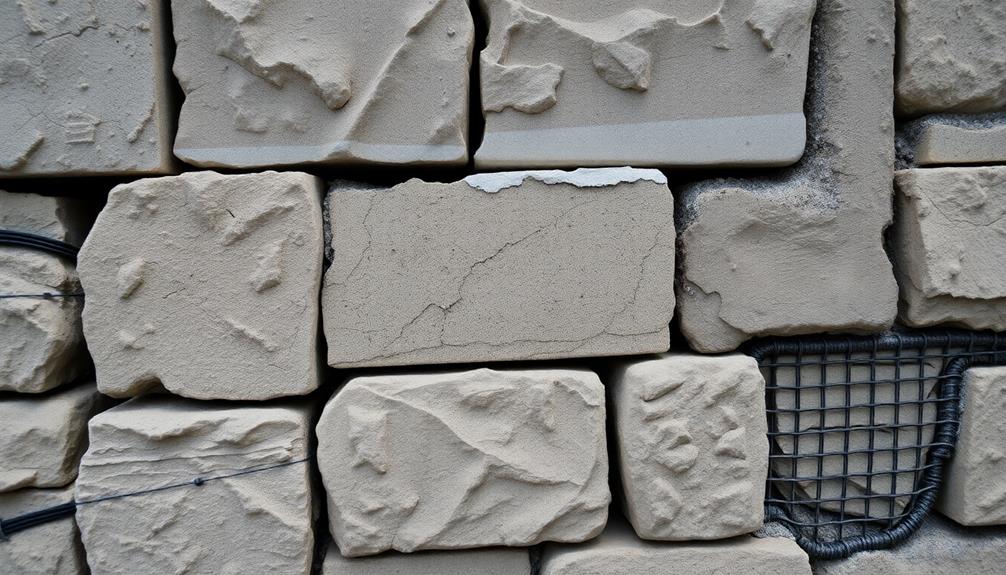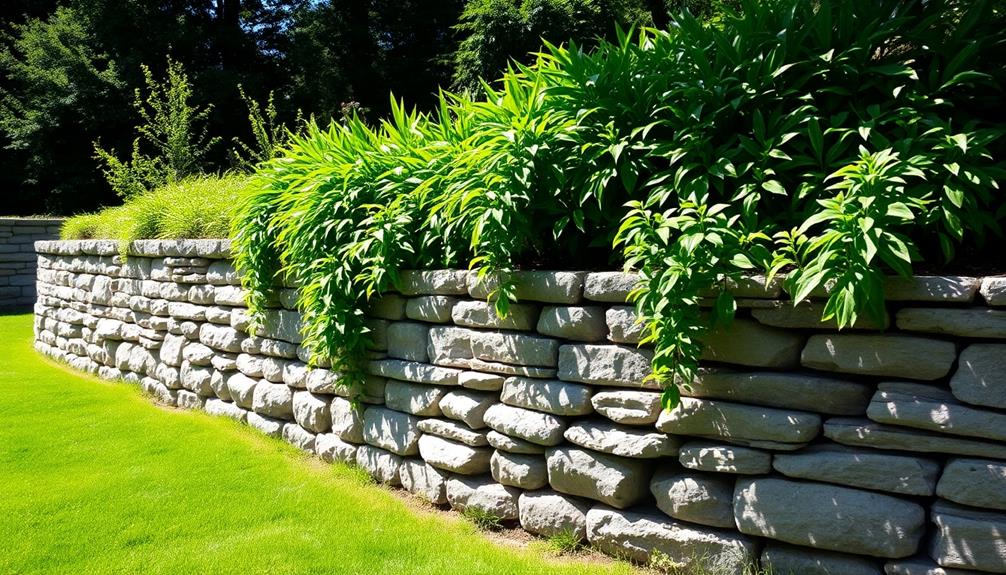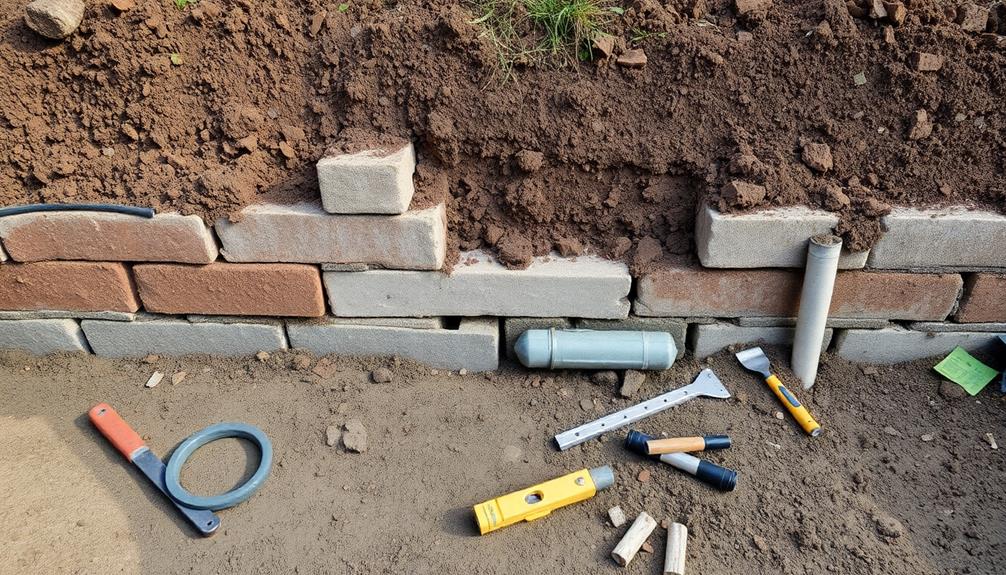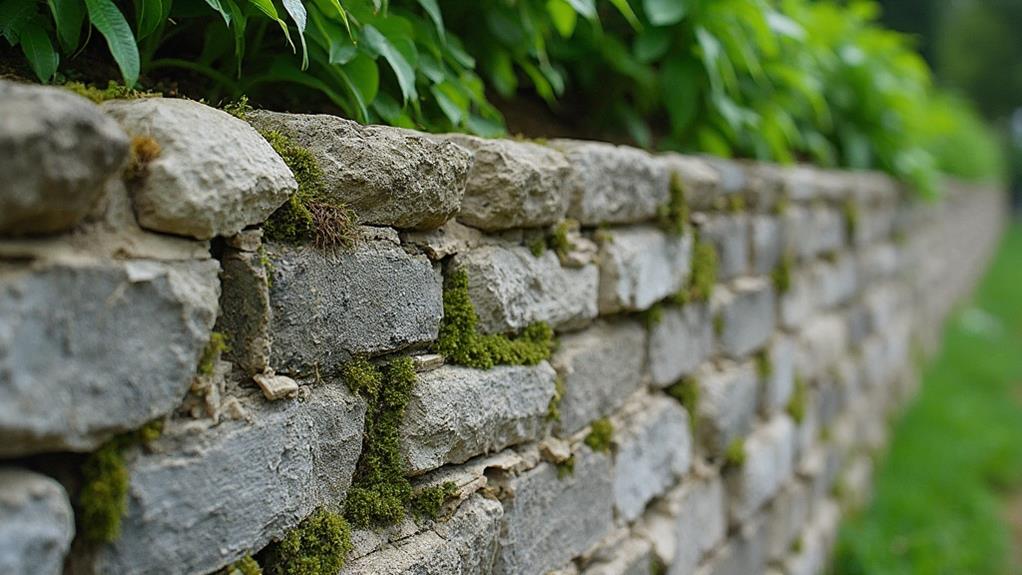When evaluating retaining wall repair techniques, prioritize methods that enhance structural stability, such as tiebacks and soil nailing, to combat lateral earth pressures. Evaluate surface crack solutions like epoxy injections and crack stitching to restore integrity and protect against moisture infiltration. Implement effective drainage improvements, utilizing weep holes and French drains to manage water pressure and safeguard against erosion. Focus on the cost-effectiveness of materials and labor, ensuring long-term savings and aesthetic appeal with high-quality designs and finishes. Understanding these strategies can lead to a more resilient wall structure, thereby contributing to property value and community safety enhancements.
Table of Contents
ToggleWalls Contractor Highlights
- Evaluate the structural stability enhancements provided by the repair technique to ensure long-term wall integrity.
- Consider the drainage improvement methods to prevent water buildup and reduce lateral pressure on the wall.
- Assess the aesthetic improvements achievable through the repair technique to enhance the property's visual appeal.
- Analyze material and labor costs to determine the most cost-effective solution for the repair project.
- Verify the potential for increased property value and community benefit from the repair technique.
Types of Repair Techniques

In addressing the various techniques for repairing retaining walls, it is essential to consider methods that stabilize the wall's structure, solutions that effectively address surface cracks, and improvements in drainage systems that prevent future damage. For example, boulder walls are known for their durability and low-maintenance features, which can influence the choice of repair method to guarantee long-term performance.
Wall stabilization often involves the use of anchors or reinforcements that safeguard long-term integrity, while surface crack solutions may include the application of sealants or patching compounds designed to restore the wall's appearance and function. Additionally, enhancing drainage through strategic installation of weep holes or French drains can noticeably reduce hydrostatic pressure, thereby prolonging the wall's lifespan and maintaining its stability.
Wall Stabilization Methods
Ensuring the stability of a retaining wall is paramount to maintaining its structural integrity and preventing potential failures. Various wall stabilization methods are employed to reinforce these structures, each tailored to address specific issues and conditions.
One common technique is the installation of tiebacks, which are steel rods or cables anchored into the soil behind the wall, providing additional support by counteracting lateral earth pressures. This method is particularly effective in situations where the wall leans or bulges outward.
Another indispensable technique involves soil nailing, where steel bars are inserted into pre-drilled holes within the soil, then grouted to create a stable mass that enhances the wall's strength. This approach is ideal for stabilizing slopes and walls in need of reinforcement. In addition, geogrid reinforcement, which utilizes polymeric materials to reinforce the soil behind the wall, can be employed to enhance the wall's load-bearing capacity.
In situations involving significant structural distress, underpinning may be necessary to extend the wall's foundation, ensuring it rests on more stable soil strata. These methods collectively provide a robust toolkit for addressing diverse stabilization needs, ensuring that retaining walls continue to serve their intended purpose effectively and safely.
Surface Crack Solutions
Surface cracks in retaining walls, though often perceived as minor, can indicate underlying structural issues that require prompt attention to prevent further deterioration. Addressing these surface imperfections is essential for maintaining the wall's integrity and supporting its long-term stability. Various repair techniques are available, each suited to the specific type and extent of the damage observed.
One effective approach for managing surface cracks is the application of epoxy injections. This technique involves injecting a high-strength epoxy resin into the cracks, effectively sealing them and restoring the wall's tensile strength. Epoxy injections are particularly beneficial for narrow cracks and can prevent water infiltration, which could exacerbate the damage over time.
For wider cracks, crack stitching is a preferred method. This involves embedding stainless steel reinforcement bars across the cracks, providing additional support and preventing further separation. The use of non-shrink grout supports a firm bond, enhancing the wall's durability.
Surface sealants may also be employed, offering a protective layer that guards against moisture ingress and environmental wear. These solutions, while seemingly straightforward, require professional assessment and application to ensure that the underlying causes are addressed, thereby fostering a sense of security and belonging within the community.
Drainage Improvement Techniques
Effective drainage plays a pivotal role in preserving the structural integrity of retaining walls, as improper water management can lead to serious damage over time. Water accumulation behind a wall increases hydrostatic pressure, potentially causing structural failures. To mitigate these risks, employing drainage improvement techniques is indispensable. These techniques not only prevent water buildup but also enhance the wall's longevity and stability, guaranteeing peace of mind for property owners.
Key drainage improvement methods include the installation of weep holes, which allow trapped water to escape, thereby reducing pressure. French drains, which comprise a trench filled with gravel and a perforated pipe, efficiently redirect water away from the wall. Incorporating geotextile fabrics can further enhance drainage by preventing soil from clogging drainage systems, maintaining their functionality over time. Additionally, surface grading around the retaining wall ensures water flows away from its base, minimizing erosion and waterlogging.
These techniques are essential for maintaining the health of retaining walls, fostering a sense of security and community among property owners. By investing in well-planned drainage systems, individuals not only protect their investments but also contribute to the collective stability and aesthetic appeal of their environments.
Benefits

Repairing a retaining wall not only enhances its structural stability, preventing potential hazards and failures, but also contributes to long-term cost savings by mitigating the need for more extensive future repairs.
In addition, a well-maintained wall can dramatically improve the aesthetic appeal of a property, creating a more attractive living environment. By maintaining these structures, property owners can take advantage of their decorative extension capabilities, turning unusable spaces into something amazing.
These improvements, in turn, have the potential to increase property value, making the investment in repair a financially prudent decision.
Enhanced Structural Stability
When reinforced appropriately, retaining wall repair techniques greatly enhance structural stability, providing long-term benefits such as improved load-bearing capacity and resistance to environmental stressors. This reinforcement guarantees that retaining walls can effectively withstand different forces, such as soil pressure, water flow, and dynamic loads from nearby construction. By fortifying the wall's internal structure, these repair methods enhance its ability to maintain equilibrium, preventing potential shifts or collapses that could compromise surrounding areas.
The strategic use of materials like geosynthetics, steel reinforcements, and advanced concrete mixtures in repair processes plays a critical role in achieving enhanced stability. These materials are selected for their durability and strength, allowing the wall to adapt to varied environmental changes while maintaining its structural integrity. Additionally, techniques such as underpinning and soil nailing contribute to the stabilization of the wall by providing additional support to the existing structure.
For communities and property owners, the assurance of a stable retaining wall fosters a sense of security and belonging, as the wall becomes a reliable component of the landscape. Properly executed repairs not only address immediate concerns but also proactively safeguard against future issues, ensuring that the community's environment remains resilient and cohesive.
Long-Term Cost Savings
Investing in robust retaining wall repair techniques yields significant long-term cost savings for property owners and communities alike. When retaining walls are maintained with superior repair methods, the need for frequent, costly interventions diminishes substantially. By employing advanced materials and precise engineering principles, these techniques extend the lifespan of existing structures, thereby reducing the frequency of replacements. This proactive approach not only conserves financial resources but also minimizes disruptions to surrounding infrastructure and landscapes.
Furthermore, timely and effective repairs mitigate the risk of catastrophic wall failures, which can lead to extensive damage to adjacent properties and necessitate expensive emergency interventions. By addressing structural issues at an early stage, property owners can avert such scenarios and safeguard their investments. In addition, extensive repair solutions often incorporate sustainable practices, which can lead to further economic benefits through incentives or reduced environmental impact costs.
For communities, effective retaining wall repair fosters a sense of security and stability, reinforcing communal infrastructures and contributing to a shared sense of well-being. Ensuring that retaining walls remain structurally sound and cost-efficient is not merely a financial consideration; it is an investment in the longevity and resilience of shared spaces where community members reside and thrive.
Improved Aesthetic Appeal
A well-maintained retaining wall not only serves a functional purpose but also enhances the overall aesthetic appeal of a property. This improvement in visual appeal can be achieved through various repair techniques that focus on both structural integrity and design elements.
A properly repaired retaining wall can transform an ordinary outdoor space into a visually enthralling landscape feature, creating a welcoming environment that fosters a sense of belonging among property owners and their communities.
The selection of materials plays a vital role in achieving this aesthetic enhancement. Opting for high-quality stones, bricks, or decorative concrete can revitalize the wall's appearance, allowing it to blend seamlessly with the surrounding landscape.
Additionally, incorporating design elements such as tiered levels, integrated lighting, or natural vegetation can further elevate the wall's visual impact. These aesthetic improvements not only reflect the homeowner's style and commitment to property upkeep but also contribute to a harmonious neighborhood atmosphere.
Moreover, the expertise of skilled craftsmen guarantees that repairs are not only durable but also visually appealing. Through meticulous attention to detail and a focus on design, retaining wall repairs can transform a mundane structure into a striking feature that enriches the property's character and charm.
Increased Property Value
Enhancing the aesthetic appeal of a retaining wall does not merely serve visual purposes; it also plays a significant role in boosting property value. Well-maintained retaining walls are an indication of a property's structural integrity and aesthetic harmony, reflecting the care and attention given by its owners. When potential buyers or appraisors evaluate a property, the condition and appearance of outdoor structures such as retaining walls can substantially influence their perception of the property's overall value.
Investing in proficient retaining wall repair not only enhances durability and functionality but also elevates the marketability of the property. Prospective buyers are often drawn to homes where the landscaping is not only attractive but also suggests minimal future maintenance. A beautifully repaired retaining wall, consequently, becomes a focal point that can sway buying decisions, setting a property apart in a competitive real estate market.
Moreover, this improvement in property value is not just financial; it instills a sense of pride and belonging among community members. The enhancement of a single property can elevate the aesthetic standard of a neighborhood, fostering a communal sense of pride and contributing to a more cohesive and valued residential environment.
Cost Considerations

When evaluating the financial implications of repairing a retaining wall, it is essential to contemplate the breakdown of material expenses alongside a comprehensive analysis of labor costs, which collectively influence the overall budget. By examining these elements, property owners can make informed decisions that may lead to significant long-term savings, ensuring that the investment in wall repair is both strategic and financially sound. Below is a table outlining potential costs to consider:
| Cost Factor | Emotional Impact |
|---|---|
| Material Expenses | Initial financial burden |
| Labor Costs | Skilled expertise required |
| Repair Complexity | Potential project delays |
| Long-term Savings | Future financial relief |
Material Expenses Breakdown
Understanding the material expenses involved in retaining wall repair is essential for accurate budgeting and effective project management. When considering the repair of retaining walls, it is important to account for the diverse materials that may be required, each contributing uniquely to the overall expense. Concrete, often a primary component due to its strength and durability, can vary greatly in cost depending on quality and required volume. Additionally, specialized materials such as geogrids or geotextiles might be utilized to enhance wall stability, adding another layer to the financial outlay.
Moreover, the choice between natural stone and manufactured blocks can influence expenses; while natural stone offers aesthetic and structural benefits, it typically comes at a higher price point compared to concrete blocks. Drainage materials, including gravel and perforated pipes, are indispensable for preventing water accumulation behind the wall, which could otherwise compromise structural integrity. These components, though sometimes overlooked, are essential for a sustainable repair process.
Understanding these material costs empowers stakeholders to make informed decisions, fostering a sense of belonging in the community of individuals engaged in the preservation and enhancement of their built environment. Such knowledge not only supports fiscal prudence but also guarantees the longevity and safety of retaining wall structures.
Labor Cost Analysis
While material costs play a vital role in retaining wall repair, labor costs are equally essential and require meticulous analysis. The labor component encompasses a range of factors, including the expertise and proficiency of the workforce, the complexity of the repair work, and the time required to complete the project. Skilled laborers, who bring invaluable experience to the task, often command higher wages, reflecting the quality and efficiency of their work. This investment in skilled labor guarantees that repairs are conducted with precision, minimizing the likelihood of future issues and thereby fostering a sense of community trust and reliability.
Moreover, the intricacy of the repair process can dramatically influence labor costs. Projects requiring specialized skills, such as intricate stonework or advanced drainage solutions, may necessitate a more experienced team, thus impacting the overall expense. Time is another pivotal element; projects that demand extended hours or present unforeseen challenges can escalate labor costs, necessitating careful project management and contingency planning.
Understanding these nuances allows stakeholders to make informed decisions, aligning project goals with budgetary constraints while ensuring the structural integrity and aesthetic appeal of the retaining wall, ultimately fostering a harmonious and secure environment.
Long-term Savings Potential
Investing in high-quality materials and skilled labor for retaining wall repairs may initially seem costly, but it can yield substantial long-term savings. By opting for premium materials and experienced professionals, property owners can guarantee the structural integrity and longevity of their retaining walls. This reduces the likelihood of recurrent repairs, which can accumulate significant expenses over time.
Additionally, quality repairs can enhance the overall safety and functionality of the wall, preventing potential damage to surrounding landscapes and structures that could result in further financial burdens.
The cost considerations extend beyond the immediate expenses. High-quality repairs often come with warranties or guarantees, providing peace of mind and financial protection against unforeseen issues. This added security fosters a sense of belonging within a community, as neighbors witness the commitment to maintaining a safe, aesthetically pleasing environment. Importantly, investing in superior repair techniques contributes to the overall property value, offering potential returns if the property is sold in the future.
Ultimately, the strategic allocation of resources towards retaining wall repairs not only guarantees durability and reliability but also aligns with the broader goal of sustainable property management, benefiting both individual owners and the community at large.
Walls Contractor FAQ
How Do I Determine if My Retaining Wall Needs Repair?
Assess the structural integrity of your retaining wall by examining signs of distress such as cracks, bulging, or water pooling. Consistent maintenance and timely repairs guarantee stability, fostering a sense of security and belonging within your property's landscape.
What Signs Indicate Structural Failure in a Retaining Wall?
Signs of structural failure in a retaining wall include visible cracks, bowing, leaning, or bulging. Additionally, water pooling, soil erosion behind the wall, and the presence of gaps between blocks are critical indicators that warrant immediate attention.
How Can I Maintain a Repaired Retaining Wall to Prevent Future Issues?
To maintain a repaired retaining wall, regularly inspect for signs of wear, guarantee adequate drainage to prevent water accumulation, and address vegetation growth promptly. Engaging with a community of experts can provide valuable insights and foster a sense of belonging.
Are There Specific Materials Best Suited for Retaining Wall Repairs?
Selecting the appropriate materials for retaining wall repairs is essential. Opt for durable options like reinforced concrete, interlocking blocks, or treated timber. These materials guarantee longevity and integrity, fostering a sense of reliability and community trust in structural resilience.
Can Weather Conditions Affect the Effectiveness of Repair Techniques?
Weather conditions markedly influence retaining wall repair effectiveness. Temperature fluctuations, moisture levels, and freeze-thaw cycles can compromise materials and adhesion, necessitating adaptations in repair techniques to guarantee structural integrity and longevity, fostering community safety and cohesion.







